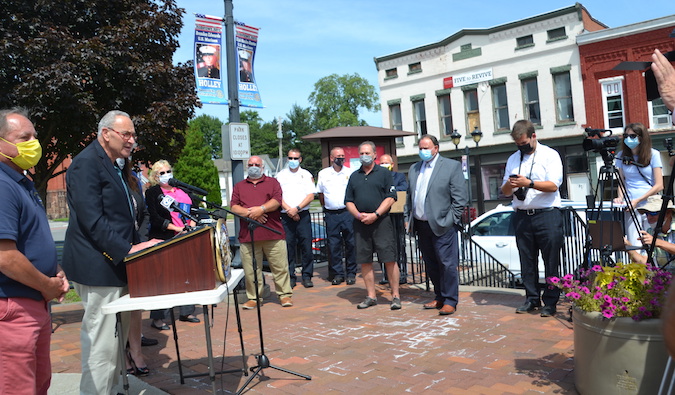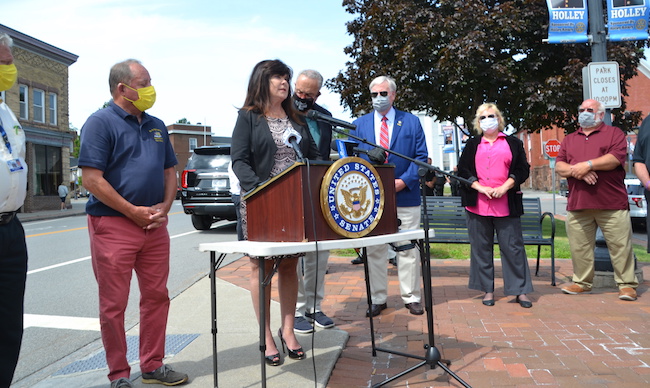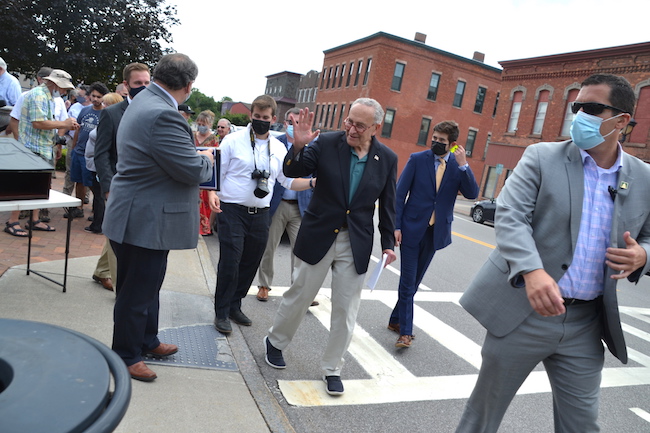Schumer in stop at Holley praises broadband push in Orleans, Niagara
Senator touts nearly $8 million in American Rescue Plan funds for project in 2 counties

Photos by Tom Rivers: U.S. Senate Majority Leader Charles Schumer speaks during a news conference today in Holley’s Public Square. He is joined by Assemblyman Steve Hawley, left, and other officials from Orleans County, the Village of Holley, Town of Murray and Community Free Library.
HOLLEY – U.S. Senate Majority Leader Charles Schumer met with local officials today to celebrate progress in the effort to close high-speed internets gaps in Orleans and rural Niagara counties.
Both counties recently approved a contract with RTO Wireless of Wellesley, Mass. to co-locate their transmitters on existing communication towers. The counties are using part of their federal American Rescue Plan funds for the build out.
“The Covid pandemic made it all too clear that the digital gap in Orleans County is far too wide,” Schumer said with local officials by the Salisbury Fountain at Public Square.
Schumer was instrumental in the American Rescue Plan being passed in the Senate. The Orleans County Legislature last month voted to spend $3,608,435 to make high-speed internet available county-wide, including for 1,351 addresses that currently don’t internet access, and another 6,700 addresses with only low-speed access. That’s nearly 40 percent of the county’s addresses without access to high-speed internet. That project should be complete in 2022.
“Whether it’s working from home, finding a new job, completing schoolwork, or accessing healthcare options, the rural digital divide has kept many New Yorkers from reaching their full potential,” said Lynne Johnson, chairwoman of the Orleans County Legislature. “Success in the 21st century is dependent on universal, affordable access.”

Orleans County Legislature Chairwoman Lynne Johnson said the federal funds will solve the high-speed internet crisis for thousands of homes in the county. There are 1,351 addresses without access to high-speed internet and another 6,700 out of 22,000 total addresses with only access to low-speed internet.
Orleans and Niagara counties are both working with RTO Wireless of Wellesley, Mass. The Niagara County Legislature earlier this month approved a $4,286,325 bid to make high-speed internet in unserved areas of the county.
In Orleans, RTO will co-locate their technology on existing county-owned communication towers. Those sites include at the Emergency Management Office on West County House Road in Albion, Route 31A in Clarendon, Maple Ridge Road in Medina, Route 31 in Albion next to Public Safety Building, West Avenue in Lyndonville, Route 237 in Kendall, Route 237 in Holley by the water tank.
Orleans and Niagara have been working together for a decade on the project. The Niagara-Orleans Regional Alliance made it a priority but only now has it had the funds to proceed with closing the internet gaps.
“The money is there,” said Niagara County Legislator David Godfrey. “We’re going to make it happen.”
Schumer also said broadband internet access is a key to reversing the population decline in rural areas. The U.S. Census Bureau last week released population counts for each county in the United States.
The data shows a 5.9 percent decline in Orleans County, which was biggest drop among Western New York counties and most in the GLOW region. Orleans shrunk by 2,540 people in the 10 years, according to the U.S. Census Bureau, dropping from 42,883 in 2010 to 40,343 in 2020.
“Broadband is really vital,” Schumer said. “In this new world where broadband connects you, it will bring more businesses here, it will keep businesses here, you will have more people come live here. Lots of people want to live in a beautiful place like this. But if they can’t be connected, they lose out.”

U.S. Senate Majority Leader Charles Schumer waves to people during a stop in Holley today. He was influential in the redevelopment of the former Holley High School as well as the cleanup of the former Diaz Chemical site in Holley.
Schumer said there will also be funding available to help people pay the costs to connect to the internet, and there will be assistance to help pay for the service.
The infrastructure bill that passed in the Senate includes $42.45 billion nationwide for broadband grants in unserved and underserved communities, $14.2 billion for permanent broadband affordability (with eligibility at 200 percent the federal poverty level), and $2.75 billion for “Digital Equity and Inclusion” – providing digital literacy and skills to low-income residents, senior citizens and people with disabilities.
Lynne Johnson also highlighted a new program through the Federal Communications Commission that offers financial assistance for monthly internet. Click here for more information.





























































